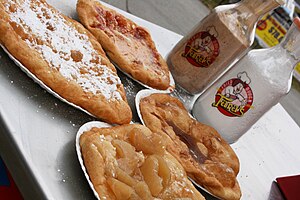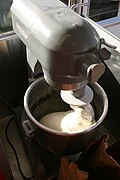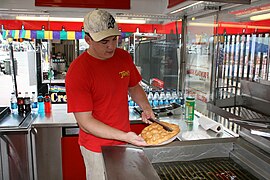
A doughnut or donut is a type of food made from leavened fried dough. It is popular in many countries and is prepared in various forms as a sweet snack that can be homemade or purchased in bakeries, supermarkets, food stalls, and franchised specialty vendors. Doughnut is the traditional spelling, while donut is the simplified version; the terms are used interchangeably.

Beignet is a type of fritter, or deep-fried pastry, made from pâte à choux, but may also be made from other types of dough, including yeast dough. In France there are at least 20 different versions. They can vary in shape, the flour used for the dough, and the filling. They are popular in French, Italian, and French-American cuisines.

A zeppola is an Italian pastry consisting of a deep-fried dough ball of varying size but typically about 4 inches (10 cm) in diameter. This fritter is usually topped with powdered sugar, and may be filled with custard, jelly, cannoli-style pastry cream, or a butter-and-honey mixture. The consistency ranges from light and puffy, to bread- or pasta-like. It is eaten to celebrate Saint Joseph's Day, which is a Catholic feast day.

Canadian cuisine consists of the cooking traditions and practices of Canada, with regional variances around the country. First Nations and Inuit have practiced their culinary traditions in what is now Canada since time immemorial. The advent of European explorers and settlers, first on the east coast and then throughout the wider territories of New France, British North America and Canada, saw the melding of foreign recipes, cooking techniques, and ingredients with indigenous flora and fauna. Modern Canadian cuisine has maintained this dedication to local ingredients and terroir, as exemplified in the naming of specific ingredients based on their locale, such as Malpeque oysters or Alberta beef. Accordingly, Canadian cuisine privileges the quality of ingredients and regionality, and may be broadly defined as a national tradition of "creole" culinary practices, based on the complex multicultural and geographically diverse nature of both historical and contemporary Canadian society.

Ukrainian cuisine is the collection of the various cooking traditions of the people of Ukraine, one of the largest and most populous European countries. It is heavily influenced by the rich dark soil (chornozem) from which its ingredients come, and often involves many components. Traditional Ukrainian dishes often experience a complex heating process – "at first they are fried or boiled, and then stewed or baked. This is the most distinctive feature of Ukrainian cuisine".

A Berliner is a German jam doughnut with no central hole, made from sweet yeast dough fried in lard or cooking oil, with a jam filling, and usually covered in powdered or conventional sugar.

Motabbaq is a stuffed pancake or pan-fried bread which is commonly found in the Arabian Peninsula, South Asia and Southeast Asia, notably in Saudi Arabia, Yemen, Indonesia, Malaysia, Singapore, Brunei, Southern Thailand and Bangladesh. Depending on the location, the name and ingredients can significantly vary. The name mutabbaq in Arabic means "folded". It is a popular street food in Yemen, Indonesia, Malaysia, Thailand and Singapore.

Lángos is a typical Hungarian food. Today it is a deep fried flatbread, but in the past it was made of the last bits of the bread-dough and baked at the front of the brick or clay oven, to be served hot as the breakfast of the bread-baking day.

A buñuelo (Spanish:[buˈɲwelo], alternatively called boñuelo, bimuelo, birmuelo, bermuelo, bumuelo, burmuelo, or bonuelo, is a fried dough fritter found in Spain, Latin America, and other regions with a historical connection to Spaniards, including Southwest Europe, the Balkans, Anatolia, and other parts of Asia and North Africa. Buñuelos are traditionally prepared at Christmas. It will usually have a filling or a topping. In Mexican cuisine, it is often served with a syrup made with piloncillo.
Parāoa rēwena is a type of sourdough bread from New Zealand. The bread is leavened with a fermented potato starter that is commonly known as a bug. It originated amongst the Māori people and is closely associated with Māori cuisine. The bread is also known as Rēwena bread or Māori bread.

Puff-puff is a traditional snack made of fried dough and eaten across Africa, especially in the west of the continent. The name "puff-puff" is from Nigeria, but many other names and varieties of the pastry exist.

Touton is a traditional dish from Newfoundland, most usually thought of as a pancake-like bread dough commonly made with risen dough. Although pancakes are rarely made from homemade bread dough in Newfoundland, the memory of regional terms still exists in younger generations, such as the British English term tiffin, meaning "small lunch". The dish has a long list of regionally-distinct names, and can refer to two different types of baked or fried dough: the dough cake variant, usually fried; and a baked bun variant, made with pork fat. Toutons are usually served at breakfast or brunch and are on the breakfast menus of many local restaurants.

Regional street food is street food that has commonalities within a region or culture.

Swabian cuisine is native to Swabia, a region in southwestern Germany comprising great parts of Württemberg and the Bavarian part of Swabia. Swabian cuisine has a reputation for being rustic, but rich and hearty. Fresh egg pastas, soups, and sausages are among Swabia's best-known types of dishes, and Swabian cuisine tends to require broths or sauces; dishes are rarely "dry".

A babka is a sweet braided bread which originated in the Jewish communities of Poland and Ukraine. It is popular in Israel and in the Jewish diaspora. It is prepared with a yeast-leavened dough that is rolled out and spread with a filling such as chocolate, cinnamon, fruit, or cheese, then rolled up and braided before baking.
























